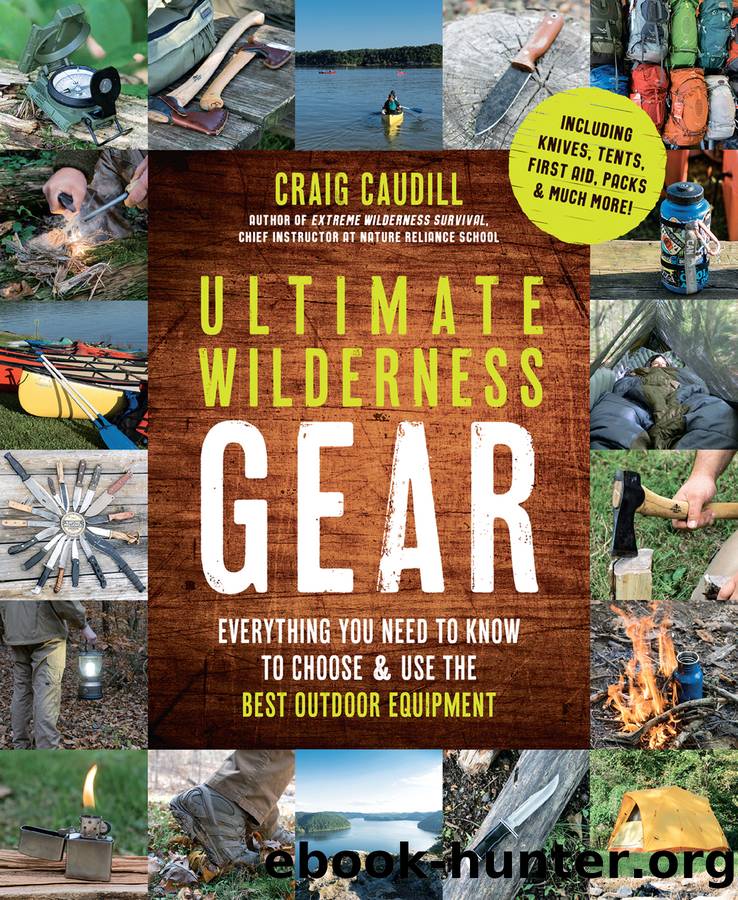Ultimate Wilderness Gear by Craig Caudill

Author:Craig Caudill [Caudill, Craig]
Language: eng
Format: epub
Publisher: Page Street Publishing
Published: 2018-06-04T00:00:00+00:00
REAL-LIFE SKILLS: SETTING UP A TENT TO AVOID GETTING WET WHEN IT RAINS
I have watched dozens of students make the following mistakes in our classes and get wet. This little sidebar is worth the price of the book you have in your hand:
⢠ALWAYS INSPECT YOUR GEAR BEFORE YOUR TRIP. Coat your shelter with waterproof sealant if you have not used it in a long while or if the sealant is cracking. This will look like white flakes over the tent. I coat my tents each year.
⢠IDENTIFY WHERE THE PREVAILING WINDS ARE WHEN SETTING UP AND WHEN WINDS START BLOWING IN A STORM. Ensure your door is not facing the prevailing winds. If it is, change its location while you have time. It is not better to hope for the best in this situation. It is better to prepare for the worst.
⢠AVOID SETTING UP AT THE BOTTOM OF SLOPE. Water naturally travels downhill. If this cannot be avoided, then dig a small âmoteâ around your tent to direct that water away from you.
⢠USE A FOOTPRINT. These are small tarps that fit the bottom of your tent perfectly. You can use any tarp; just ensure that it does not stick out from the bottom of your tent. When you have a tarp that sticks out from the bottom, it serves as a guttering system for water to travel under your tent. I have seen suggestions to have it 1 inch (3 cm) in from the edge, flush and much more. My experience is that as long as it does not protrude out from under the main body of the tent, you are okay. The more any portion of the floor touches the earth, the more opportunity there is for moisture to seep in. Waterbeds are not a good choice in the wilderness. Although a footprint is the easiest to use for such endeavors, it does not serve any other purpose very well. Therefore, I take a regular Equinox or Wilderness Innovation tarp to use instead. This way, I have another item with me that is multiuse.
⢠ONCE YOUâRE INSIDE THE TENT, DO NOT TOUCH THE SIDES OF ANY PORTION THAT CONTACTS THE OUTSIDE WITH YOUR BODY OR GEAR. A conduit will be created by manipulating the fibers by touching them or other equipment making contact with them. An outer barrier is made by the tightly woven fibers of the material; when the material is pushed, the fibers are pulled apart (although this cannot be seen with the naked eye), which allows moisture to pass through. This is another good reason to choose a double-walled tent. You can avoid this issue altogether by doing so.
⢠ANOTHER BIG ISSUE IS SETTING UP YOUR TENT IN THE RAIN. One way I take care of this is that I leave my rainfly attached. If it is raining when I set it up, I can pull it out and it is already covered by the rainfly. This does not work for an extended time, but does make for quick work in the rain.
Download
This site does not store any files on its server. We only index and link to content provided by other sites. Please contact the content providers to delete copyright contents if any and email us, we'll remove relevant links or contents immediately.
In a Sunburned Country by Bill Bryson(3373)
Annapurna by Maurice Herzog(3301)
How to Read Nature by Tristan Gooley(3081)
Dangerous Girls by Haas Abigail(2842)
SAS Survival Handbook by John 'Lofty' Wiseman(2583)
The Lost Art of Reading Nature's Signs by Tristan Gooley(2549)
In the Woods by Tana French(2419)
The Stranger in the Woods by Michael Finkel(2330)
Food and Water in an Emergency by Food & Water In An Emergency(2273)
Guns, Germs and Steel by Diamond Jared(2203)
Wild: From Lost to Found on the Pacific Crest Trail by Cheryl Strayed(2134)
Everest the Cruel Way by Joe Tasker(2134)
Backpacker the Complete Guide to Backpacking by Backpacker Magazine(2111)
Trail Magic by Trevelyan Quest Edwards & Hazel Edwards(2063)
Ultimate Navigation Manual by Lyle Brotherton(2055)
Sea Survival Handbook by Keith Colwell(2044)
Welcome to the Goddamn Ice Cube by Blair Braverman(1888)
Birds of the Pacific Northwest by Shewey John; Blount Tim;(1876)
The Last Flight by Julie Clark(1833)
